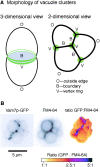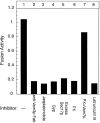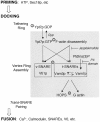Hierarchy of protein assembly at the vertex ring domain for yeast vacuole docking and fusion
- PMID: 12566429
- PMCID: PMC2172665
- DOI: 10.1083/jcb.200209095
Hierarchy of protein assembly at the vertex ring domain for yeast vacuole docking and fusion
Abstract
Vacuole tethering, docking, and fusion proteins assemble into a "vertex ring" around the apposed membranes of tethered vacuoles before catalyzing fusion. Inhibitors of the fusion reaction selectively interrupt protein assembly into the vertex ring, establishing a causal assembly hierarchy: (a) The Rab GTPase Ypt7p mediates vacuole tethering and forms the initial vertex ring, independent of t-SNAREs or actin; (b) F-actin disassembly and GTP-bound Ypt7p direct the localization of other fusion factors; (c) The t-SNAREs Vam3p and Vam7p regulate each other's vertex enrichment, but do not affect Ypt7p localization. The v-SNARE Vti1p is enriched at vertices by a distinct pathway that is independent of the t-SNAREs, whereas both t-SNAREs will localize to vertices when trans-pairing of SNAREs is blocked. Thus, trans-SNARE pairing is not required for SNARE vertex enrichment; and (d) The t-SNAREs regulate the vertex enrichment of both G-actin and the Ypt7p effector complex for homotypic fusion and vacuole protein sorting (HOPS). In accord with this hierarchy concept, the HOPS complex, at the end of the vertex assembly hierarchy, is most enriched at those vertices with abundant Ypt7p, which is at the start of the hierarchy. Our findings provide a unique view of the functional relationships between GTPases, SNAREs, and actin in membrane fusion.
Figures








Similar articles
-
Interdependent assembly of specific regulatory lipids and membrane fusion proteins into the vertex ring domain of docked vacuoles.J Cell Biol. 2004 Dec 20;167(6):1087-98. doi: 10.1083/jcb.200409068. J Cell Biol. 2004. PMID: 15611334 Free PMC article.
-
Three v-SNAREs and two t-SNAREs, present in a pentameric cis-SNARE complex on isolated vacuoles, are essential for homotypic fusion.J Cell Biol. 1999 Jun 28;145(7):1435-42. doi: 10.1083/jcb.145.7.1435. J Cell Biol. 1999. PMID: 10385523 Free PMC article.
-
The N-terminal domain of the t-SNARE Vam3p coordinates priming and docking in yeast vacuole fusion.Mol Biol Cell. 2001 Nov;12(11):3375-85. doi: 10.1091/mbc.12.11.3375. Mol Biol Cell. 2001. PMID: 11694574 Free PMC article.
-
SNARE protein structure and function.Annu Rev Cell Dev Biol. 2003;19:493-517. doi: 10.1146/annurev.cellbio.19.110701.155609. Annu Rev Cell Dev Biol. 2003. PMID: 14570579 Review.
-
Membrane dynamics and fusion at late endosomes and vacuoles--Rab regulation, multisubunit tethering complexes and SNAREs.Eur J Cell Biol. 2011 Sep;90(9):779-85. doi: 10.1016/j.ejcb.2011.04.007. Epub 2011 Jun 16. Eur J Cell Biol. 2011. PMID: 21683469 Review.
Cited by
-
N-terminal domain of vacuolar SNARE Vam7p promotes trans-SNARE complex assembly.Proc Natl Acad Sci U S A. 2012 Oct 30;109(44):17936-41. doi: 10.1073/pnas.1216201109. Epub 2012 Oct 15. Proc Natl Acad Sci U S A. 2012. PMID: 23071309 Free PMC article.
-
The lipid composition and physical properties of the yeast vacuole affect the hemifusion-fusion transition.Traffic. 2013 Jun;14(6):650-62. doi: 10.1111/tra.12064. Epub 2013 Mar 20. Traffic. 2013. PMID: 23438067 Free PMC article.
-
The yeast vacuolar Rab GTPase Ypt7p has an activity beyond membrane recruitment of the homotypic fusion and protein sorting-Class C Vps complex.Biochem J. 2012 Apr 1;443(1):205-11. doi: 10.1042/BJ20110687. Biochem J. 2012. PMID: 22417749 Free PMC article.
-
Vacuolar membrane dynamics in the filamentous fungus Aspergillus oryzae.Eukaryot Cell. 2006 Feb;5(2):411-21. doi: 10.1128/EC.5.2.411-421.2006. Eukaryot Cell. 2006. PMID: 16467481 Free PMC article.
-
A soluble SNARE drives rapid docking, bypassing ATP and Sec17/18p for vacuole fusion.EMBO J. 2004 Jul 21;23(14):2765-76. doi: 10.1038/sj.emboj.7600286. Epub 2004 Jul 8. EMBO J. 2004. PMID: 15241469 Free PMC article.
References
-
- Bennett, M.K., N. Calakos, and R.H. Scheller. 1992. Syntaxin: a synaptic protein implicated in docking of synaptic vesicles at presynaptic active zones. Science. 257:255–259. - PubMed
-
- Bromley, S.K., W.R. Burack, K.G. Johnson, K. Somersalo, T.N. Sims, C. Sumen, M.M. Davis, A.S. Shaw, P.M. Allen, and M.L. Dustin. 2001. The immunological synapse. Annu. Rev. Immunol. 19:375–396. - PubMed
Publication types
MeSH terms
Substances
Grants and funding
LinkOut - more resources
Full Text Sources
Molecular Biology Databases

